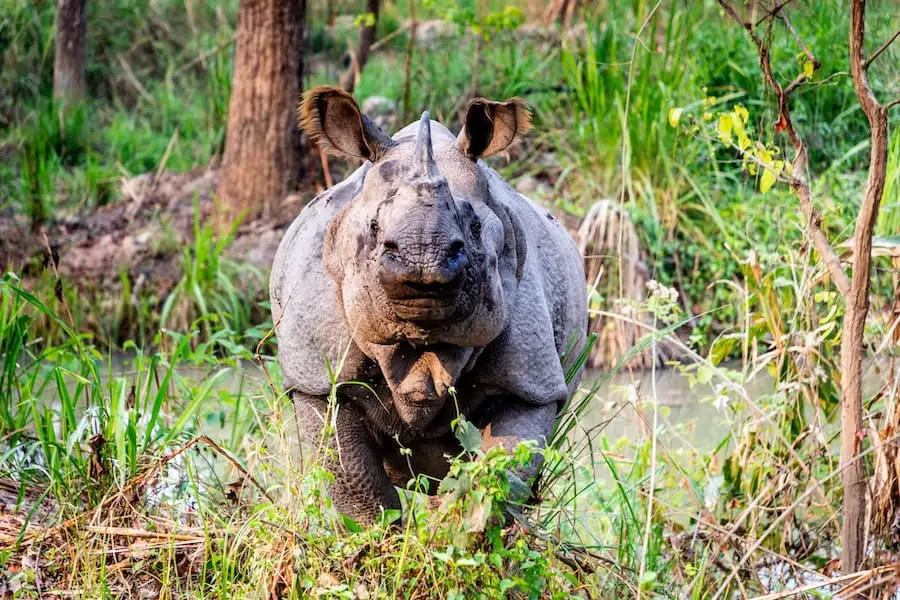Nepal, known better for its high mountains, is actually also a very typographically and geographically diverse country. The plains closer to the Indian border, and the Terai home to lush jungles and vast wildlife, which might be a surprise and highlight for many travelers. Therefore, if you’re traveling in Nepal, Chitwan National Park is a must-visit! To help you out on your journey, make sure to use this Chitwan Travel Guide to find out everything there is to know about the National Park.
A UNESCO World Natural Heritage Site in Nepal, the Chitwan National Park is surrounded by grasslands, forests, and wildlife which will truly give a wild experience. Chitwan National Park is also the first national park in Nepal. It was established in 1973 and received the status of the UNESCO World Natural Heritage site in 1984.
Located in the sub-tropical Terai lowlands of south-central Nepal, the national covers an area of approx 952 sq. km and covers other districts like Nawaparasi, Parsa, Makwanpur, and Chitwan. Moreover, Chitwan is one of the four tourist cities in Nepal – Kathmandu, Pokhara, Chitwan and Lumbini.
Book a visit to Chitwan National Park to experience Nepal’s most fascinating wildlife and nature treasure trove. Discover Nepal’s impressive wildlife, which includes rhinos, Bengal tigers, deers, and much more!
History of Chitwan
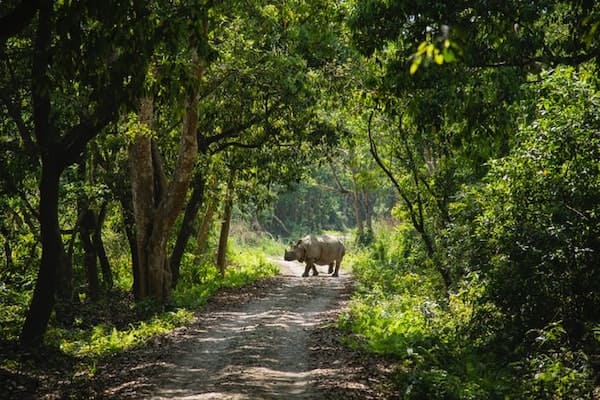
After the 19th century, known as the Heart of the Jungle, Chitwan used to be a hunting ground for Nepal’s elite and ruling class. Until the 1950s, traveling to the south corners of the country was strenuous as it could only be reached by foot. Camps were set up for the feudal hunters and their companions where they would spend their time hunting for rhinos, tigers, elephants, and bears.
In the 1950s, Chitwan’s forest and grassland had extended to over more than 2600 sq. km. and was home to about 800 rhinos. However, after farmers moved to that area from the mid-hills, poaching of the wildlife became rampant. Then in 1957, to save the extinction of the rhinos and their habitat, the country’s first conservation law took effect to protect the wildlife. Edward Pritchard Gee in 1959, surveyed the national park area and recommended creating a protected area on the north side of the Rapti River and a wildlife sanctuary south of the river for a trial period of ten years.
However, by the end of the 1960s, 70% of Chitwan’s jungles had been cleared, thousands of people settled and the number of rhinos reduced to 95. This drastic decline of the rhino population and extensive poaching of the mammal, induced the government to establish the Garda Gasti – a rhino search patrol of 130 armed men and a network of guard posts throughout Chitwan.
In 1977, the park was extended to its current area of 952.63 sq. km. In 1997, a buffer zone of 766.1 sq. km was also added to the north and west of the Narayani-Rapti river, and between the southeast boundary of the park and the border with India.
The park’s headquarters is Kasari and is close to the gharial (alligator) and turtle conservation breeding centers. In 2008, a vulture breeding center was also established to prevent the extinction of the Gyps vulture species.
Wildlife at Chitwan National Park
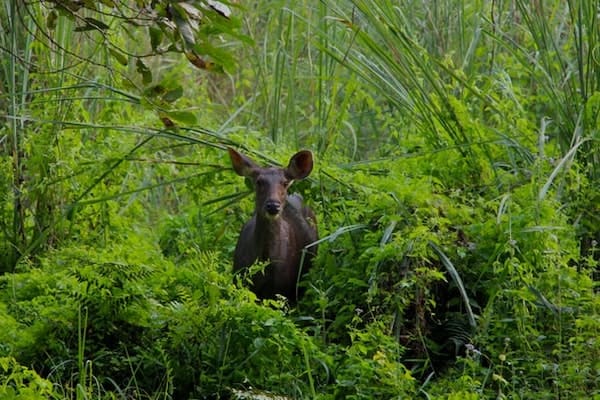
A treasure trove in the heart of the Terai, Chitwan National Park covers thick forests, mystic rivers, and wildlife to surprise you. Adjacent to the east of Chitwan National Park is Parsa National Park and to the south is the Indian Tiger Reserve, Valmiki National Park. Together these parks represent a total of 3549 sq. k. wide Tiger Conservation Project over the alluvial grasslands and subtropical deciduous forests.
Chitwan National Park is home to 68 mammal species, including the “king of the jungle”, the Bengal tiger. The alluvial floodplain habitat of the Terai makes it one of the best habitats for the tiger. Indian leopards are also one of the most prevalent mammals on the premises of the park. Chitwan is also considered to have the highest population density of sloth bears. Otters inhabit the numerous creeks. Striped hyenas live on the southern slopes of the Churia Hills, Bengal foxes, spotted linsangs and honey badgers are also seen in the park.
Other animals such as the golden jackals, fishing and jungle cats, leopard carts, Indian civets, Asian palm civets, yellow-throated martens, amber deer, red muntjac, hog deer, and herds of chital inhabit the park. Furthermore, 112 animals were counted in the adjacent Parsa Wildlife Reserve and animals move freely between these parks. Four-horned antelopes are predominant in the hills, rhesus monkeys, grey langurs, Indian pangolins, and porcupines, and specials of flying squirrels, hares, and endangered hispid hares are also found in the park.
Birds of Chitwan National Park

The population of several species of avian creatures in Chitwan National Park makes it a paradise for bird enthusiasts and watchers. It is home to many rare and migratory birds. The grasslands of the national park are breeding grounds for several species of birds like the Bengal Florian, adjutants, Grey-crowned prints and species of grass warbles, the near-threatened Oriental darter, and the spotted eagle.
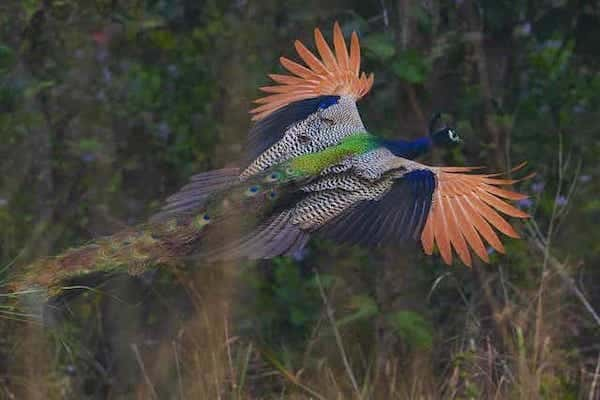
Apart from the residential birds, there are about 160 migratory birds and vagrant species that arrive in the national park in autumn. Among them are the greater spotted eagle, eastern imperial eagle, Pallas’s fish eagle, brahminy ducks and goosanders, and large flocks of bar-headed geese in February.
As soon as the winter season is over, visitors for the summer arrival from the southern latitudes. Birds like cuckoos, colorful pitta, and several sunbird species are common during the monsoon season as well. Among the several flycatcher species, the Indian paradise flycatcher is a spectacular sight with a long undulating tail in flight.
Flora and Fauna Chitwan Travel Guide

The wide variety of vegetation types in the Chitwan National Park is home to more than 700 species of wildlife! Species like the king cobra, rock python, and 17 other species of snakes, starred tortoise, and monitor lizards are also seen in the park. The small tributaries of the Narayani-Rapti river system are also home to 113 recorded species of fish and mugger crocodiles.
Due to the drastic decline of the Gharials in 2003, every year Gharial eggs are collected along the rivers and are brought to the breeding center, the Gharial Conservation Project, where the eggs are hatched and animals are looked after to age from 6-9 years. Every year young gharials are sent back to the Narayani-Rapti river system, however, only a few survive,
Tharus of Chitwan: Experience the Culture

It wouldn’t be fair to come to Chitwan National Park and not visit the village of the Tharu community who are the original inhabitants of Chitwan. The Tharu village can be explored on foot or you can go on a traditional famous ox-cart ride. Your guide will explain all the nuances of the everyday life of Tharus, their past, present, culture and insights into their religion.
The Tharus also perform cultural programs for visitors in their village. Young men and women dressed in traditional dresses that are bright and colorful traditional costumes, dance to their folk songs and request to join in their musical feat.
There is also the Tharu Cultural Museum which houses the evolution of the Tharu people from the past to the present. It is represented through photographs, documents, weapons, potteries, and other things they have used over the years. There are also handicraft shops outside, from where you can buy souvenirs like Nepali Pashmina, and Dhaka Fabrics to remember your wild trip in the Terai!
Curious about what Tharus eat? Well they have a dish called Ghongi, which is fried snails! If you are wanting to try this weird food in Nepal, you’re in luck cuz you can find it in Chitwan!
Bish Hazari Taal
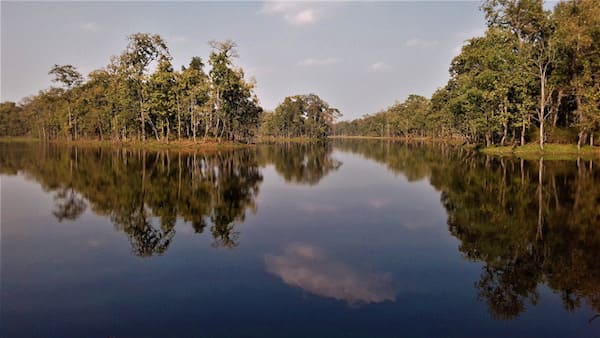
The Bish Hazari Taal or the 20 Thousand Lake is also a highlight in Chitwan. It is a protected area in the inner Terai and is in the buffer zone of the Chitwan National Park. The wetland covers an area of 7,900 acres and is set between the Lower Himalayan Range to the north and the Siwalik range to the south. Due to several divisions of the water body present in the area, the looks like many small and big lakes, separate but clustered together, therefore the name Bish Hazari Taal. The area is also a nesting and breeding ground for many native and migratory birds, which makes it a heaven for bird watchers.
Chitwan Travel Guide: Activities to do in the National Park
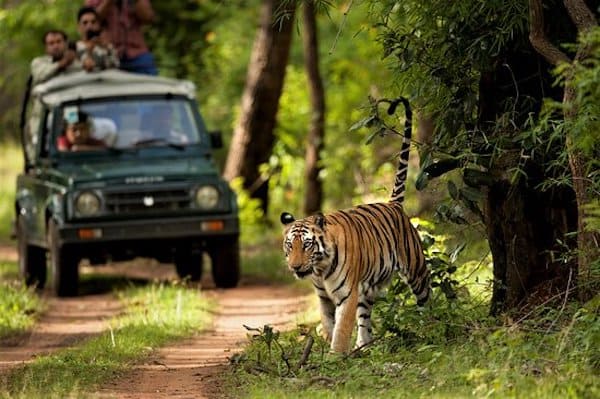
Many national parks are only limited to jeep safaris; however, Chitwan National Park offers many exciting and fun activities. While jeep safari is indeed a fun activity and takes you to the Gharial Crocodile Breeding Center at the headquarters in Kasara.
If you’re looking for something more adventurous, you can also opt for safari walks. Taking the tour of the forest on foot as you smell nature and wildlife surrounding you, and the anticipation of waiting to peek at a wild animal anytime is quite thrilling! If you’re a bird enthusiast, you can also hire a professional so that they can take you through safer routes and have higher chances of spotting birds. Elephant back safari is also available however I wouldn’t encourage doing it as it is animal cruelty and many elephants are not treated well.

The Chitwan National Park is also striving to make the forest area a safer place for the mammals residing there. The Elephant Breeding Center in Chitwan is one of the best in Asia. You can see how well the elephants are taken care of and their calves are kept and fed in a friendly and safe environment. In another location in Sauraha, you can also feed elephants and bathe them in the Rapti river! Quite a new and fun experience in the Terai!
Another exciting activity to indulge in is the canoe ride! A slow and relaxing ride down the river stream is one hell of an experience. You can see birds and gharials basking in the sun as you pass through them in the stream. However, don’t try to call them or make noise around the gharials as you don’t want your reptile friend too close to you! Take the canoe ride either in the morning or evening to experience the serenity of the auburn sun, pink and purple hues, and rich light radiating into the river as it sets behind the forests.
Chitwan National Park is a dense jungle rich with exotic wildlife and fauna. Embarking on a safari walk in search of a deer or a rhino, or a canoe ride in the evening as you watch the sunset is what makes Chitwan National Park so appealing and pleasant. It’s the perfect place to experience a different side of Nepal and experience a rustic and wild experience that is truly magical!
Chitwan has much to offer for tourists! It is a family friendly environment as well as is a great place for elderly people. This is why I added this Chitwan travel guide to my favorite places to visit in Nepal. Additionally, the National park is a family friendly travel destinations in Nepal. The hotels, resorts, restaurants, and Nepali tour guides speak good English, making it an easy place to travel to in Nepal.
FAQs: Chitwan National Park
The following three questions cover the three most frequently asked questions regarding Chitwan that we recieve:
Chitwan National Park is situated in south central Nepal in the sub-tropical lowlands of the inner terai of Chitwan, Nawalparsai, Makawanpur, and Parsa districts.
The best time to visit Chitwan National Park is October to early March for pleasant 25°C temperatures, but if you think you can stand the heat, April to May for meltingly hot temperatures that are mid 40°Cs. January is the coldest month and can be freezing at night, however, daytime temperatures are warm!
Chitwan National Park was established in 1973, as Nepal’s first National Park. It covers an area of 952.63 sq. km and extends over four districts: Chitwan, Nawalparasi, Parsa, and Makwanpur.
